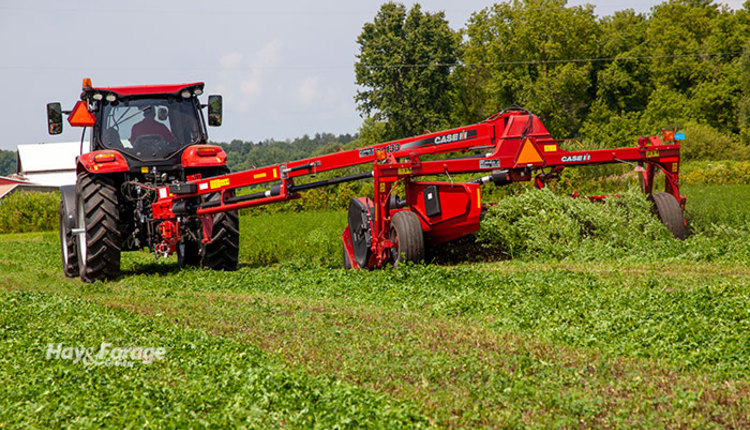Is the risk of fall alfalfa cutting overrated? |
| By Mike Rankin, Managing Editor |
|
|
 Although Labor Day doesn’t mark the official beginning of fall, it’s difficult to classify September as a summer month. Across the central region of the United States and points north, it’s usually during the cooler temperatures of September that a dormant alfalfa variety shifts its game plan, partitioning nutrients and resources into the roots as it transitions to winter survival mode. As the air turns cool, rapid and abundant top growth for an alfalfa plant becomes secondary but still important to maintain a photosynthetic factory. Moving to the top of the priority list is root carbohydrate (starch) and protein storage. Roughly six weeks preceding a killing freeze, staying out of alfalfa fields with anything that resembles a cutting machine has long been recommended. This hiatus from human field intervention offers plants adequate time to prepare for winter and is sometimes referred to as the “critical fall period.” For a good chunk of the dormant alfalfa-growing region, the recommended no-cut period begins in early to mid-September, depending on latitude and perhaps elevation. It lasts until the point when alfalfa essentially quits growing because of cold temperatures, usually mid- to late October. Times have changed Thirty years ago, convincing a producer not to cut during the critical fall period was an easy task. Some years, even if they didn’t cut, alfalfa was a no-show the next spring. If they did roll the dice and cut, it was almost a sure bet that stands would suffer significant damage. Over the years, the fall-cutting waters have become murkier for several reasons. Although cutting during the critical fall period remains a risk, it’s less so than it used to be. There are probably a couple of reasons for this. There was a time when the fall dormancy rating of an alfalfa variety was highly correlated with its winterhardiness. Those varieties with less dormancy usually performed at a higher yield level because their regrowth was both earlier and faster. They also grew later into the fall. It was often these varieties that, if cut at the wrong time in the fall, were subject to devastating winterkill. Pre-2000 alfalfa growers often had to make the choice between higher yield potential or growing a variety with a lower risk for winterkill. During subsequent years, the situation has changed. The link between fall dormancy and winter survival has long been broken. In other words, there are varieties with a fall dormancy rating of 4 or 5 that are just as winterhardy as those with a fall dormancy rating of 2 or 3. Most plant breeders now make their dormant variety selections after purposely cutting them during the traditional critical fall period. This helps to ensure plant survivability under a wide range of fall-cutting regimes. There are two important considerations when the planted variety needs to be taken into account before making a fall-cutting decision. First, you have to make sure that you are using an improved variety with a high level of winter survival. Not all varieties fit into this category. The other consideration is simply that Mother Nature can still humble genetics when weather conditions are extreme. Your risk level is much better with an improved variety, but it’s not zero. Changing weather Call it what you will, but there is a preponderance of evidence to support the notion that growing seasons are, on average, getting longer and average killing frost dates are occurring later. These weather-related mutations don’t change the underlying principles of root nutrient status going into winter, but they do effectively push back the critical fall-cutting period. This allows for alfalfa plants to prepare for winter with a later harvest date than what was previously the case. In reality, the critical fall harvest period isn’t about calendar dates; it’s about getting enough growing degree units following the last cutting for adequate regrowth. What does all of this mean? On average, cutting on September 15 in 2022, for example, will more than likely allow for a greater number of growing degree units before a growth-stopping frost than cutting on the same date 30 years ago. Even so, the reality that any year can offer the possibility of an early killing freeze must always be factored into the fall-cutting decision. Several other considerations come into play when assessing the risk level of a fall cutting. These include the intensity of the previous cutting schedule, the current soil fertility status, any previous pest stressors, and stand age. Stands that have been subjected to intensive cutting regimes, that lack soil fertility, or that have been stressed by diseases and/or insects will be less likely to overcome the additional stress of a fall cut. Older stands also are more vulnerable to winter injury from fall cutting than younger stands. Ultimately, the decision to cut during the fall period may come down to the need for additional forage. If the forage isn’t needed, why take the risk? As for taking a cutting after alfalfa plant growth has ceased later in the fall, that’s a discussion for another day. |
